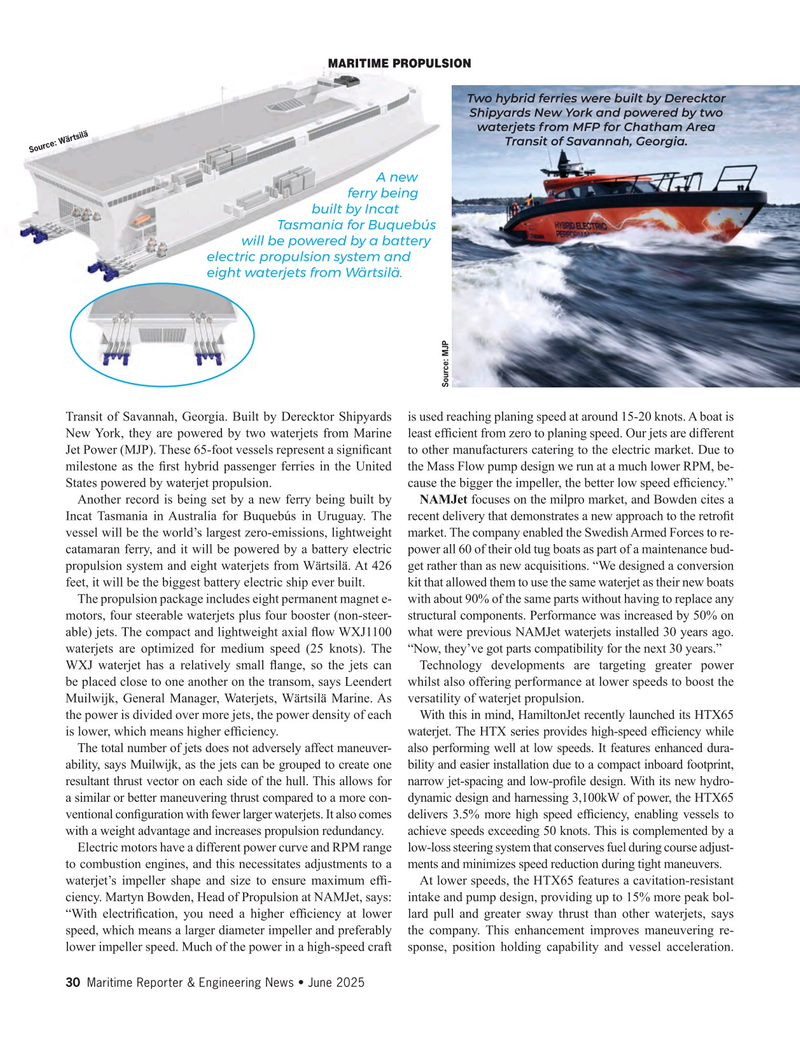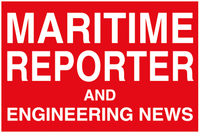
Page 30: of Maritime Reporter Magazine (June 2025)
Read this page in Pdf, Flash or Html5 edition of June 2025 Maritime Reporter Magazine
MARITIME PROPULSION
Two hybrid ferries were built by Derecktor
Shipyards New York and powered by two waterjets from MFP for Chatham Area
Transit of Savannah, Georgia.
Source: Wärtsilä
A new ferry being built by Incat
Tasmania for Buquebús will be powered by a battery electric propulsion system and eight waterjets from Wärtsilä.
Source: MJP
Transit of Savannah, Georgia. Built by Derecktor Shipyards is used reaching planing speed at around 15-20 knots. A boat is
New York, they are powered by two waterjets from Marine least ef? cient from zero to planing speed. Our jets are different
Jet Power (MJP). These 65-foot vessels represent a signi? cant to other manufacturers catering to the electric market. Due to milestone as the ? rst hybrid passenger ferries in the United the Mass Flow pump design we run at a much lower RPM, be-
States powered by waterjet propulsion. cause the bigger the impeller, the better low speed ef? ciency.”
Another record is being set by a new ferry being built by NAMJet focuses on the milpro market, and Bowden cites a
Incat Tasmania in Australia for Buquebús in Uruguay. The recent delivery that demonstrates a new approach to the retro? t vessel will be the world’s largest zero-emissions, lightweight market. The company enabled the Swedish Armed Forces to re- catamaran ferry, and it will be powered by a battery electric power all 60 of their old tug boats as part of a maintenance bud- propulsion system and eight waterjets from Wärtsilä. At 426 get rather than as new acquisitions. “We designed a conversion feet, it will be the biggest battery electric ship ever built. kit that allowed them to use the same waterjet as their new boats
The propulsion package includes eight permanent magnet e- with about 90% of the same parts without having to replace any motors, four steerable waterjets plus four booster (non-steer- structural components. Performance was increased by 50% on able) jets. The compact and lightweight axial ? ow WXJ1100 what were previous NAMJet waterjets installed 30 years ago. waterjets are optimized for medium speed (25 knots). The “Now, they’ve got parts compatibility for the next 30 years.”
WXJ waterjet has a relatively small ? ange, so the jets can Technology developments are targeting greater power be placed close to one another on the transom, says Leendert whilst also offering performance at lower speeds to boost the
Muilwijk, General Manager, Waterjets, Wärtsilä Marine. As versatility of waterjet propulsion. the power is divided over more jets, the power density of each With this in mind, HamiltonJet recently launched its HTX65 is lower, which means higher ef? ciency. waterjet. The HTX series provides high-speed ef? ciency while
The total number of jets does not adversely affect maneuver- also performing well at low speeds. It features enhanced dura- ability, says Muilwijk, as the jets can be grouped to create one bility and easier installation due to a compact inboard footprint, resultant thrust vector on each side of the hull. This allows for narrow jet-spacing and low-pro? le design. With its new hydro- a similar or better maneuvering thrust compared to a more con- dynamic design and harnessing 3,100kW of power, the HTX65 ventional con? guration with fewer larger waterjets. It also comes delivers 3.5% more high speed ef? ciency, enabling vessels to with a weight advantage and increases propulsion redundancy. achieve speeds exceeding 50 knots. This is complemented by a
Electric motors have a different power curve and RPM range low-loss steering system that conserves fuel during course adjust- to combustion engines, and this necessitates adjustments to a ments and minimizes speed reduction during tight maneuvers.
waterjet’s impeller shape and size to ensure maximum ef? - At lower speeds, the HTX65 features a cavitation-resistant ciency. Martyn Bowden, Head of Propulsion at NAMJet, says: intake and pump design, providing up to 15% more peak bol- “With electri? cation, you need a higher ef? ciency at lower lard pull and greater sway thrust than other waterjets, says speed, which means a larger diameter impeller and preferably the company. This enhancement improves maneuvering re- lower impeller speed. Much of the power in a high-speed craft sponse, position holding capability and vessel acceleration. 30 Maritime Reporter & Engineering News • June 2025
MR #6 (18-33).indd 30 MR #6 (18-33).indd 30 5/31/2025 8:14:14 PM5/31/2025 8:14:14 PM

 29
29

 31
31
